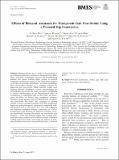Effects of Bilateral Assistance for Hemiparetic Gait Post-Stroke Using a Powered Hip Exoskeleton
Author(s)
Pan, Yi-Tsen; Kang, Inseung; Joh, James; Kim, Patrick; Herrin, Kinsey R.; Kesar, Trisha M.; Sawicki, Gregory S.; Young, Aaron J.; ... Show more Show less
Download10439_2022_Article_3041.pdf (1.461Mb)
Publisher with Creative Commons License
Publisher with Creative Commons License
Creative Commons Attribution
Terms of use
Metadata
Show full item recordAbstract
Abstract
Hemiparetic gait due to stroke is characterized by an asymmetric gait due to weakness in the paretic lower limb. These inter-limb asymmetries increase the biomechanical demand and reduce walking speed, leading to reduced community mobility and quality of life. With recent progress in the field of wearable technologies, powered exoskeletons have shown great promise as a potential solution for improving gait post-stroke. While previous studies have adopted different exoskeleton control methodologies for restoring gait post-stroke, the results are highly variable due to limited understanding of the biomechanical effect of exoskeletons on hemiparetic gait. In this study, we investigated the effect of different hip exoskeleton assistance strategies on gait function and gait biomechanics of individuals post-stroke. We found that, compared to walking without a device, powered assistance from hip exoskeletons improved stroke participants’ self-selected overground walking speed by 17.6 ± 2.5% and 11.1 ± 2.7% with a bilateral and unilateral assistance strategy, respectively (p < 0.05). Furthermore, both bilateral and unilateral assistance strategies significantly increased the paretic and non-paretic step length (p < 0.05). Our findings suggest that powered assistance from hip exoskeletons is an effective means to increase walking speed post-stroke and tuning the balance of assistance between non-paretic and paretic limbs (i.e., a bilateral strategy) may be most effective to maximize performance gains.
Date issued
2022-08-13Department
Massachusetts Institute of Technology. Department of Brain and Cognitive SciencesPublisher
Springer International Publishing
Citation
Pan, Yi-Tsen, Kang, Inseung, Joh, James, Kim, Patrick, Herrin, Kinsey R. et al. 2022. "Effects of Bilateral Assistance for Hemiparetic Gait Post-Stroke Using a Powered Hip Exoskeleton."
Version: Final published version